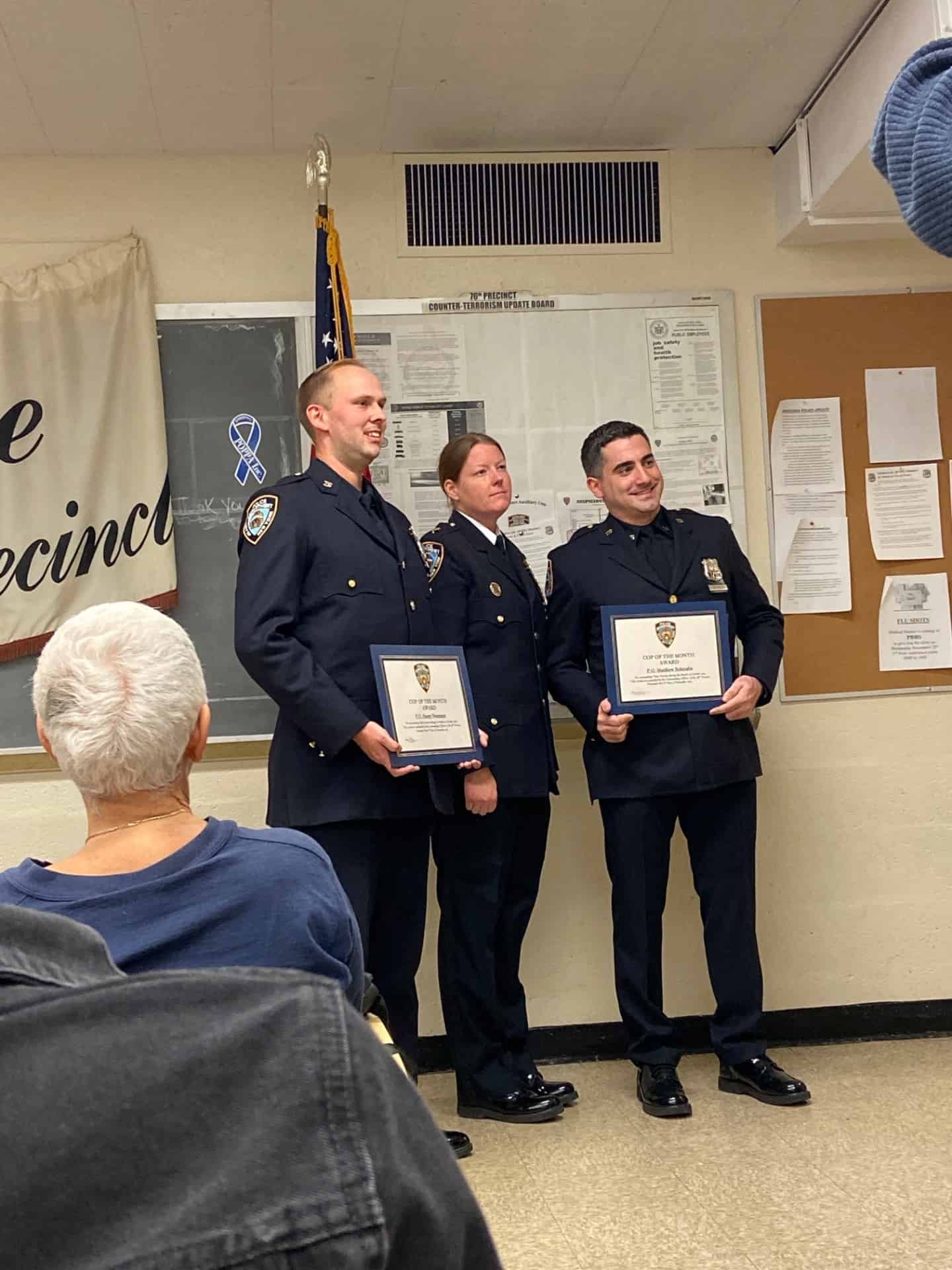The NYPD’s 76th Precinct, the police station that serves South Brooklyn, holds a Community Council meeting on the first Wednesday of each month to update residents on recent incidents and local crime statistics. One regular feature of the meeting – the Cop of the Month award, delivered to one or more officers responsible for an exemplary deed – became a source of controversy in November when Deputy Inspector Megan O’Malley chose to celebrate officers Henry Neumann and Matthew Schmalix for their involvement in a fatal shooting in the Gowanus Houses on October 15.
According to the narrative provided by NYPD on the night of the incident, two Anti-Crime Unit officers had intervened to stop a shooting in progress on the corner of Baltic and Hoyt streets. They ordered 30-year-old Nasheem Prioleau to drop his weapon, a 9-millimeter semiautomatic, while his target fled. Instead, Prioleau turned his gun on the police, who opened fire in response. The officers escaped without injury, but Prioleau died from gunshot wounds later that night.
The NYPD had withheld the officers’ names from the press following the incident, which made the subsequent public ceremony for Neumann and Schmalix a surprise to the Community Council audience. Some questioned the appropriateness of celebrating a local man’s death as a triumph of policing, even if the circumstances had justified the officers’ actions on the scene.
Zac Martin, the founder of the local community development nonprofit Trellis, called the decision “tone-deaf” after attending the meeting. By his account, the 76th Precinct’s own presentation – which, in its ambiguous description of a shootout in Gowanus, avoided direct mention of the deadly nature of the incident – reflected a buried awareness of its insensitivity. “If the Community Council had shared that someone the police had descended upon was killed as a result of their gunfire, I’m not sure people would’ve been quite as excited about them receiving Cop of the Month,” Martin speculated.
In the Gowanus Houses, doubts linger about the veracity of the official story of Prioleau’s death and about the conduct of the officers involved. NYCHA has not released surveillance video from the night of October 15, and because the two officers who shot Prioleau were plainclothes cops, body camera footage is unlikely to exist. (If it did, NYPD would have no obligation to release it.) The family has not seen a police report, and law does not require the NYPD to provide them with one. While the Brooklyn District Attorney’s Office’s Law Enforcement Accountability Bureau has opened a file on the incident as a matter of standard procedure (and NYPD protocol similarly mandates an in-house review of all instances of lethal force by the Force Investigation Division), Prioleau’s case does not fall under the purview of the 2015 executive order by Governor Cuomo that requires the New York State Attorney General to conduct independent investigations of police-involved deaths of unarmed civilians. The other civilian noted at the scene – Prioleau’s alleged target, before NYPD stepped in – appears to have vanished.
As a result, community members have questions that, thanks to NYPD’s reticence, may continue to go unanswered. How many bullets did the officers discharge? Where did they aim? As plainclothes cops, did they offer Prioleau identification and a real chance to relinquish his gun before opening fire? Can an impartial witness confirm their story? What caused the initial gunfight that brought NYPD to the scene?
The victim’s cousin, Tracey Pinkard, wished the 76th Precinct were “more forthcoming” with information about the final moments of Prioleau’s life. “We’re basically just going off what we heard from NYPD through the media,” she said.
Pinkard emphasized that the entire neighborhood – not just her own family – deserved a thorough, public account of an incident that reportedly had left a total of 30 bullet holes in a residential area, putting bystanders and neighbors at risk. But in her view, the 76th Precinct showed its disregard early on for the Gowanus Houses community – which has suffered from police violence in the past, most infamously in the 1994 case of Nicholas Naquan Heyward Jr. – by refusing during the incident’s immediate aftermath to provide basic details to family members, including, initially, the location of the dying victim.
The NYCHA resident recalled her frantic questions on the night of her cousin’s shooting as NYPD guarded the crime scene: “‘Can you tell me where he is? Can you tell me whether he’s alive? Can you tell me what type of injuries he sustained and how critical they are?’ No one seemed to know. They were sending us around, kind of ping-ponging us. ‘Well, we believe he’s at Methodist Hospital – no, we believe he’s at Brooklyn Hospital. No, we believe he’s at Maimonides.’ It became a grassroots effort to just locate him.” At Brooklyn Hospital’s emergency room, NYPD refused family members access to the victim until, at about 1 a.m., they found out that Prioleau had died.
For Pinkard, the Cop of the Month award represented a final slap in the face. “Even if a person is doing something wrong, I can’t imagine how you would accept an honor for taking someone’s life,” she commented.
A representative for Assembly Member Jo Anne Simon confirmed that, alongside congresswoman Nydia Velázquez, her office would be working to organize a meeting that would seek to open a dialogue between the 76th Precinct and Gowanus Houses residents in the wake of the shooting and its aftermath. Its date has not yet been determined.
The NYPD’s Office of the Deputy Commissioner, Public Information, did not respond to the Star-Revue’s media request, and at December’s Community Council meeting, Deputy Inspector O’Malley declined to comment on the Gowanus Houses shooting or the subsequent Community Council controversy. For the first time in recent memory, the 76th Precinct did not name a Cop of the Month in December.
Update: On January 10, the NYPD publicly released footage of the shooting.









